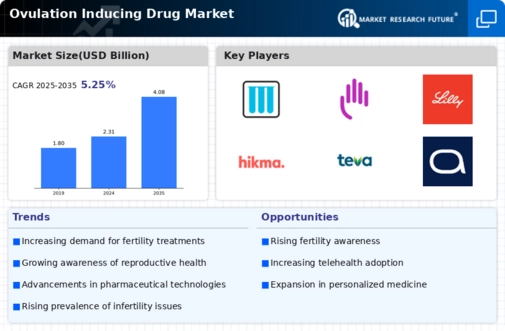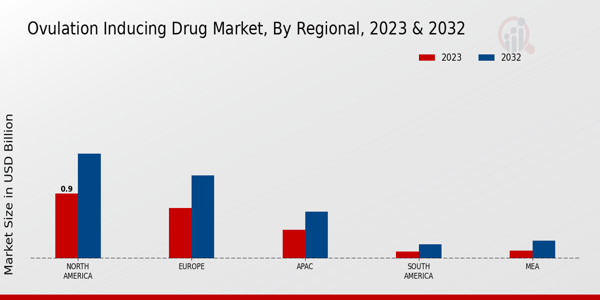Increasing Infertility Rates
The Global Ovulation Inducing Drug Market Industry is experiencing growth due to rising infertility rates worldwide. Factors such as delayed childbearing, lifestyle changes, and environmental influences contribute to this trend. In many regions, infertility affects approximately 15% of couples, prompting a greater demand for ovulation-inducing medications. As awareness of fertility issues grows, more individuals seek medical assistance, thereby increasing the market's potential. The industry is projected to reach 2.31 USD Billion in 2024, reflecting the urgent need for effective treatments to address infertility challenges globally.
Rising Awareness and Education
The Global Ovulation Inducing Drug Market Industry benefits from increasing awareness and education regarding fertility issues. Campaigns aimed at educating the public about reproductive health and available treatment options are becoming more prevalent. Healthcare providers are also emphasizing the importance of early intervention in cases of infertility. This heightened awareness encourages couples to seek medical advice sooner, leading to increased prescriptions of ovulation-inducing drugs. As a result, the market is poised for growth, with a projected value of 2.31 USD Billion in 2024, reflecting the impact of informed decision-making on treatment accessibility.
Government Initiatives and Support
Government initiatives aimed at addressing infertility issues significantly influence the Global Ovulation Inducing Drug Market Industry. Many countries are implementing policies to promote reproductive health and provide financial assistance for fertility treatments. For example, some governments offer subsidies for ovulation-inducing drugs, making them more accessible to couples facing infertility. Such support not only encourages individuals to seek treatment but also fosters a more favorable environment for the growth of the ovulation drug market. This trend is likely to sustain the industry's expansion, especially as the market is expected to grow at a CAGR of 5.31% from 2025 to 2035.
Advancements in Pharmaceutical Research
Innovations in pharmaceutical research play a pivotal role in the Global Ovulation Inducing Drug Market Industry. Ongoing research and development efforts lead to the introduction of new and more effective ovulation-inducing drugs. These advancements not only enhance treatment efficacy but also improve patient safety profiles. For instance, the development of selective estrogen receptor modulators has shown promise in stimulating ovulation with fewer side effects. As the market evolves, it is anticipated that these innovations will contribute to the industry's growth, with projections indicating a market value of 4.08 USD Billion by 2035.
Technological Integration in Healthcare
The integration of technology in healthcare is transforming the Global Ovulation Inducing Drug Market Industry. Telemedicine, mobile health applications, and online consultations are making it easier for individuals to access fertility treatments. These technological advancements facilitate timely diagnosis and treatment, allowing patients to receive personalized care from the comfort of their homes. As more patients utilize these services, the demand for ovulation-inducing drugs is likely to increase. This trend aligns with the overall growth of the industry, which is expected to reach 4.08 USD Billion by 2035, driven by enhanced patient engagement and accessibility.



 Source: Primary Research, Secondary Research, MRFR Database and Analyst Review
Source: Primary Research, Secondary Research, MRFR Database and Analyst Review


















Leave a Comment